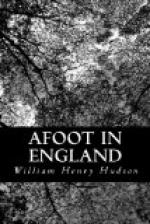’Tis useless, he tells us, to hang these slain robbers about the fields, since in a little while they are no more regarded than the men of rags and straw with sham rifles in their hands. It was for him to shift the dead from place to place, to arrange them in dying attitudes with outstretched wings. Finally, there was the fox, the stealer of dead crows, to be guarded against; and again at eventide Giles must trudge round to gather up his dead and suspend them from twigs out of reach of hungry night-prowlers. Called up at daybreak each morning, he would take his way through deep lanes overarched with oaks to “fields remote from home” to redistribute his dead birds, then to fetch the cows, and here we have an example of his close naturalist-like observation in his account of the leading cow, the one who coming and going on all occasions is allowed precedence, who maintains her station, “won by many a broil,” with just pride. A picture of the cool dairy and its work succeeds, and a lament on the effect of the greed and luxury of the over-populous capital which drains the whole country-side of all produce, which makes the Suffolk dairy-wives run mad for cream, leaving nothing but the “three-times skimmed sky-blue” to make cheese for local consumption. What a cheese it is, that has the virtue of a post, which turns the stoutest blade, and is at last flung in despair into the hog-trough, where
It
rests in perfect spite,
Too big to swallow and too hard
to bite!
We then come to the sheep, “for Giles was shepherd too,” and here there is more evidence of his observant eye when he describes the character of the animals, also in what follows about the young lambs, which forms the best passage in this part. I remember that, when first reading it, being then little past boyhood myself, how much I was struck by the vivid beautiful description of a crowd of young lambs challenging each other to a game, especially at a spot where they have a mound or hillock for a playground which takes them with a sort of goatlike joyous madness. For how often in those days I used to ride out to where the flock of one to two thousand sheep were scattered on the plain, to sit on my pony and watch the glad romps of the little lambs with keenest delight! I cannot but think that Bloomfield’s fidelity to nature in such pictures as these does or should count for something in considering his work. He concludes:-
Adown the slope, then up the hillock
climb,
Where every mole-hill is a bed of
thyme,
Then panting stop; yet scarcely
can refrain;
A bird, a leaf, will set them off
again;
Or if a gale with strength unusual
blow,
Scattering the wild-briar roses
into snow,
Their little limbs increasing efforts
try,
Like a torn rose the fair assemblage
fly.
This image of the wind-scattered petals of the wild rose reminds him bitterly of the destined end of these joyous young lives—his white-fleeced little fellow-mortals. He sees the murdering butcher coming in his cart to demand the firstlings of the flock; he cannot suppress a cry of grief and indignation—he can only strive to shut out the shocking image from his soul!




